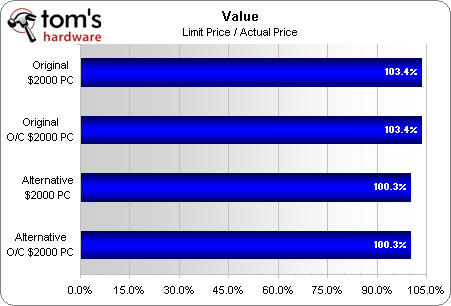System Builder Marathon, June 2011: Alternative $2000 PC
Conclusion
Builders asked about the Cooler Master HAF X, and we had the parts in place to answer that question. Rebuilding with this case allowed noticeably reduced GPU temperatures with a noticeable increase in noise.
The problem was that our original overclocks weren’t limited by GPU cooling. Instead, the frequency of our cards was artificially capped by AMD, and we were stuck only because none of the workarounds that we could find would actually work around those limits. GPU fan speeds in excess of 55% were never required, so both configurations had GPU cooling in reserve.
Our CPU cooling was slightly closer to the limit as a result of using a cheap cooler, but again we had over 25° Celsius worth of headroom before we had to worry about throttling. The original system outperformed the HAF X in this discipline, but that slight advantage wasn’t needed. With cooling differences too small to affect our overclocking capabilities, we were left with nothing more than a comparison of case features to price.
While the new case costs 36% more than the original case, it adds only 3% to our total system cost. It adds a pair of hot-swap bays that we didn’t use, some ductwork that didn’t fit our hardware configuration, the ability to support an internal liquid cooling system that we didn’t need, and nearly 3 dB of noise. Thus, the extra money spent is really an exercise in aesthetics. While we prefer the look of anodized brushed aluminum, we’re sure that several readers will instead prefer the massive statement that a windowed steel case the size of the HAF X makes about their equipment.
Get Tom's Hardware's best news and in-depth reviews, straight to your inbox.
-
ChiefTexas_82 At least it doesn't look like a regular office PC. I thought the LL in the previous $2000 looked too 'professional' for a gaming PC.Reply -
Crashman ChiefTexas_82At least it doesn't look like a regular office PC. I thought the LL in the previous $2000 looked too 'professional' for a gaming PC.That's because it wasn't a gaming PC. Were it a gaming PC it would have lacked the 1TB storage drive and BD-R, had a Core i5 rather than Core i7, had 4GB rather than 8GB RAM, and would have put the money saved towards even faster graphics.Reply -
SpadeM ChiefTexas_82At least it doesn't look like a regular office PC. I thought the LL in the previous $2000 looked too 'professional' for a gaming PC.Reply
Well you can always bling a case up if you're so inclined but it's more difficult to un-bling one. All in all a very tame SBM this quarter, do hope u guys do something unnecessary cool next round :). BTW anything new and exciting coming up this week in the articles? -
cmcghee358 After building a nice rig for the last 2 years or so, I really want my next rig to look really classy. It's the difference between a Honda Civic with Cold Cathode lighting, and an Audi with a massive V8 under the hood. I'm looking forward to moving on to the Audi.Reply
Also yes, for the love of God, will you people please understand that these aren't gaming PCs? That's why there are so many non-gaming related benchmarks. Please see beyond your own needs.
The 1st thing I ask a potential customer is "What do you use it for?" If they say "Surfing the internet, and doing Office" I recommend an inexpensive build with Linux as an operating system. If they say gaming I recommend an appropriate build with Windows 7(Just because I hate all the tweaking Wine takes in order to work) But I hope that highlights that EVERYONE has different needs. -
yukijin CrashmanThat's because it wasn't a gaming PC. Were it a gaming PC it would have lacked the 1TB storage drive and BD-R, had a Core i5 rather than Core i7, had 4GB rather than 8GB RAM, and would have put the money saved towards even faster graphics.with the money saved from such changes, you can afford TWO GTX 580's!Reply -
compton That's the great thing about cases: there's one out there for everyone and every purpose.Reply
The last case I bought was a Lian Li PC A05NB. It's definitely different, pretty much unique, and looks classy. I tossed a piano black Samsung BD drive with a mirrored tray facade and it's got the understated style that fits in everywhere. I say right on to any case that gets tossed in to an SBM. I bet no one complains about the enclosure when they win the rig. -
sparky2010 these pc's are great.. but there's one thing missing.. if these are intended to be 'gaming' pc's, then the sound must be upgraded too.. it's not just about the graphics.. putting in a good sound card will increase the quality of the sound, and make games more enjoyable! it reall does make a difference.. so what i'd do in this case is change the 6970's to 6950's (since in crossfire, the difference won't be that great, at least at 1080p) and then get a good sound card, like an Asus Xonar or Sound Blaster X - Fi.. at least, that's what i already did and it's really great!! with a 7.1 sound system, games like Mass Effect become MUCH better... :DReply -
wrazor I was wondering if toms have a 570 GTX 2.5gb evga card review in the making. They are going for 400$ each, so replacing the 2600k here with 2500k would have covered that cost. I am very much interested(and i think many more do too)to see how these 2.5gb cards would fare in sli and stuff. 6970 killers? I think so.Reply -
kovaxo That this one is perfect , although i don't like the motherboard , but its a great build stillReply


